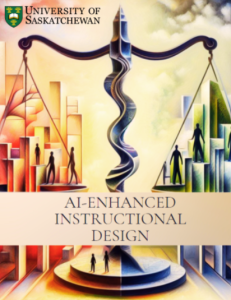Introduction
Teaching is a creative endeavor that requires an ongoing thirst for knowledge and a desire to expand one’s thinking. Effective teachers actively seek out ways to improve their classroom praxis and stay abreast of current educational pedagogy. The emergence of generative AI has dramatically altered the educational landscape, thus calling teachers everywhere to reimagine what teaching and learning look like in the new age of AI.
This textbook provides examples on how AI technology can be integrated into the classroom to support teacher planning and enhance student learning experiences. The 36 chapters are divided into four sections to help teachers easily find information to fit their professional development and planning needs: art and music, language and literacy, math and science, and general and cross-curricular education. While each chapter focuses on a different AI tool, all of the chapters reinforce the need for AI literacy in K-12 education and the importance of ethical and responsible use of AI by teachers and students alike.
This open textbook was developed for the Educational Technology and Design (ETAD) program in the College of Education, University of Saskatchewan, using a collaborative constructivist learning approach. It contributes a collection of work submitted by undergraduate students enrolled in ETAD 402: Multimedia Design and Production. Construction of this open textbook provided students with an opportunity to actively engage in a meaningful learning experience and to better “understand how educators can best leverage AI techniques for academic success of their students” (Casal-Otero er al., 2023, p.3).
Casal-Otero, L., Catala, A., Fernández-Morante, C., Taboada, M., Beatriz Cebreiro López, & Barro, S. (2023). AI literacy in K-12: a systematic literature review. International Journal of STEM Education, 10(1). https://doi.org/10.1186/s40594-023-00418-7
Book Organization
The 36 chapters of this textbook are organized into 4 thematic sub-sections for ease of navigation and to illustrate the diverse applications of AI in teaching and learning. Starting with subject specific concepts and moving into more general use cases and cross-curricular studies, the book provides detailed applications of AI’s potential role in curriculum and content development. This structured approach underscores both the general and specific influences of AI in the field of education.
Part 1: Art and Music
- How to use AI Tools to Enrich Art Education
- How to Incorporate AI into Music Education with AIVA
- ART-ificial Intelligence: The Art of AI Art
- How to Use Playground AI Canvas in Art Education
- How to use Open Art AI as a Student Resource in the Secondary Art Curriculum
Part 2: Language and Literacy
- How to Use AI to Help English Language Learners in Speaking
- How To Use AI Dungeon To Create Interactive Stories
- How to Enhance Your Writing and Grammar
- How to Create Personalized Reading Material for Developing Readers and Writers Using StoryBooks
- How to use “Eduaide” to implement differentiated instruction in a classroom
- How to Differentiate and Create Text using Diffit (and other cool features)
Part 3: Math and Science
- How to integrate PhET Interactive Simulations in teaching and learning STEM
- How to Gain Confidence and Reduce Anxiety using PhotoMath.
- How to use MagicSchool.ai to Create Math Word Problems
Part 4: General and Cross-Curricular
- How to Create Visually Appealing and Informative Presentations Using Gamma
- How to Use Easy-Peasy.AI
- How to Use TutorAI to Provide a Private & Personal Tutor for Every Student
- How to Make use of Intelligent Tutoring Systems in the Classroom
- How to use Magma to provide students with a new study tool
- How to use GAJIX to augment lessons for students who wish to delve deeper into a topic
- How to use ChatGPT as a Teacher and Student Resource
- How Students Can Use Breathing.ai to Strengthen Overall Wellbeing
- How to Transform Uploaded Videos into Interactive Micro-Learning with Nolej AI
- How to Create a Lesson Plan Using Eduaide
- How to use Enlighten AI to Save Time While Retaining Personalized Assessment for Students
- How to use Seek by iNaturalist as a Helpful Tool in the Classroom.
- How to Create an Interactive Learning Module Based on a Video, Website, or Text using NOLEJ AI
- How to utilize Fetchy as your personal teaching assistant
- Using MyLessonPal to Help Create Lesson Plans and Activities
- How to use Lumen5 (artificial intelligence) to create engaging video content
- Privacy and Security of Chat GPT
- Expanding Your Nolej: A microlearning package generator
- Using GoFormative to Streamline Teaching
- How to use MyLessonPal to Create Classroom Resources for Teachers
- How to keep up with the Modern Technological Approach to Education
For technical issues with this book or discussions relating to publishing, contact paula.macdowell@usask.ca.
ETAD 873: AI Enhanced Instructional Design
Hungry for more? The graduate students of ETAD 873 also had the opportunity to develop a textbook highlighting the use and application of AI for educational and instructional design purposes. AI Enhanced instructional Design explores effective ways AI can generate high-quality course content, foster creativity, personalize learning, and drive innovation.
Check it out:

